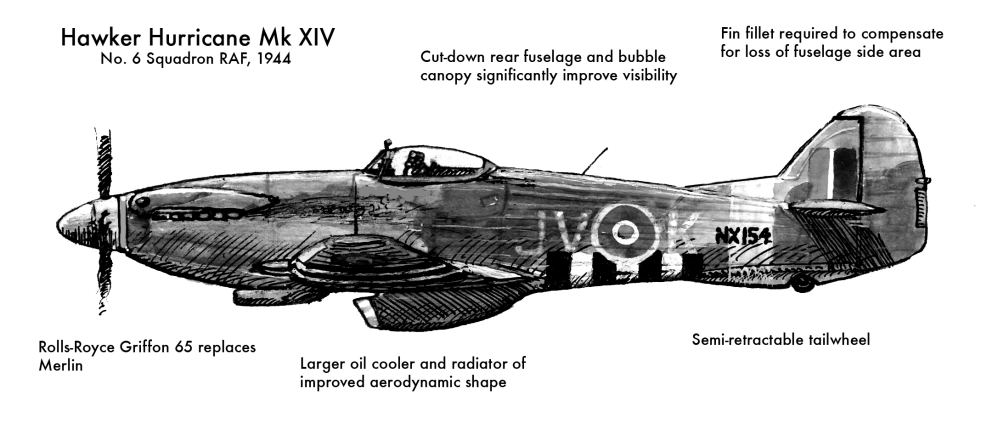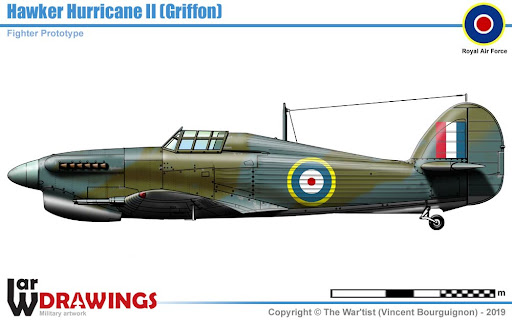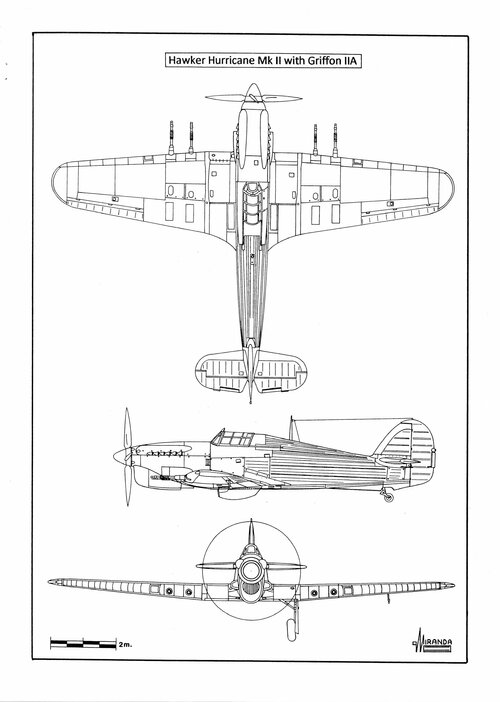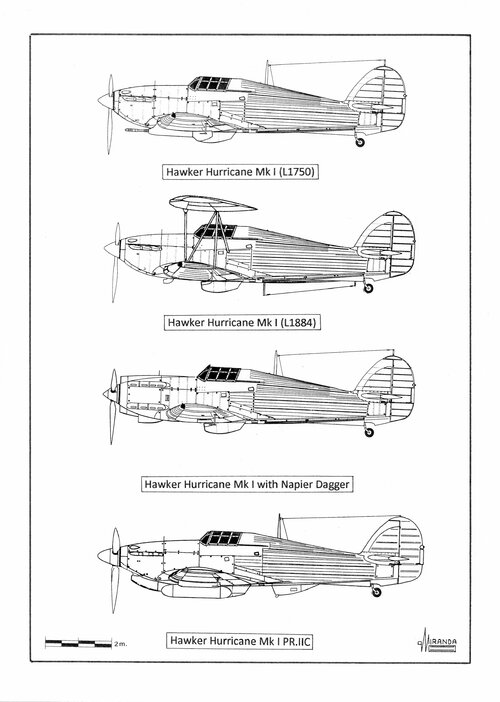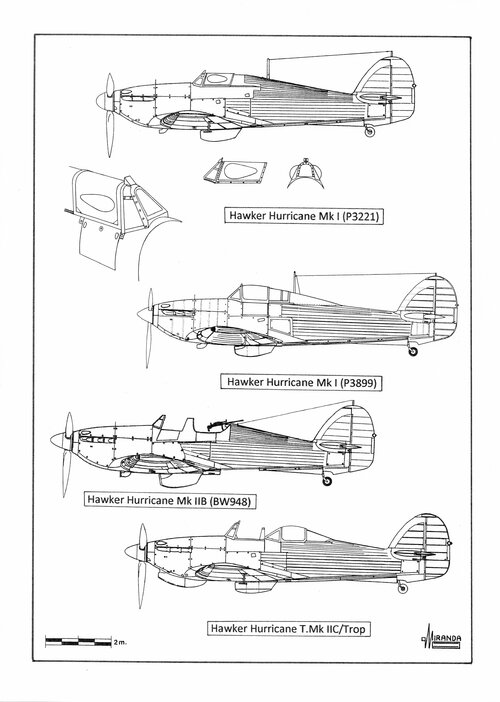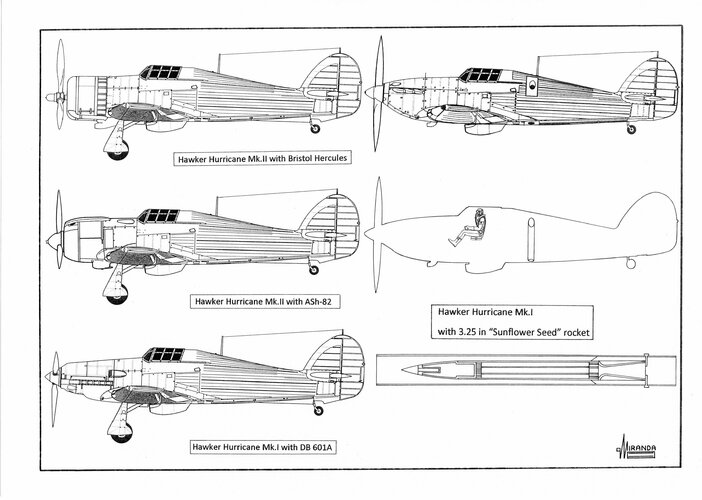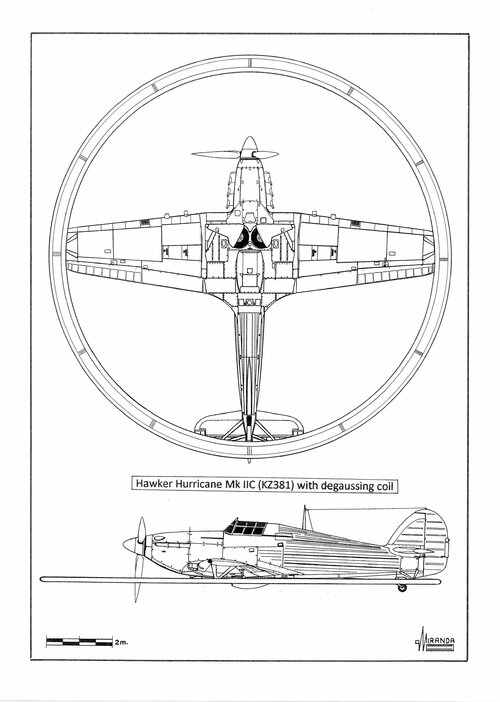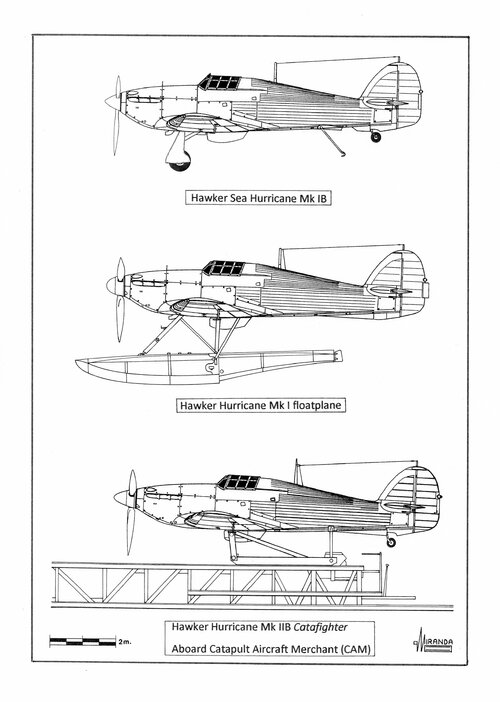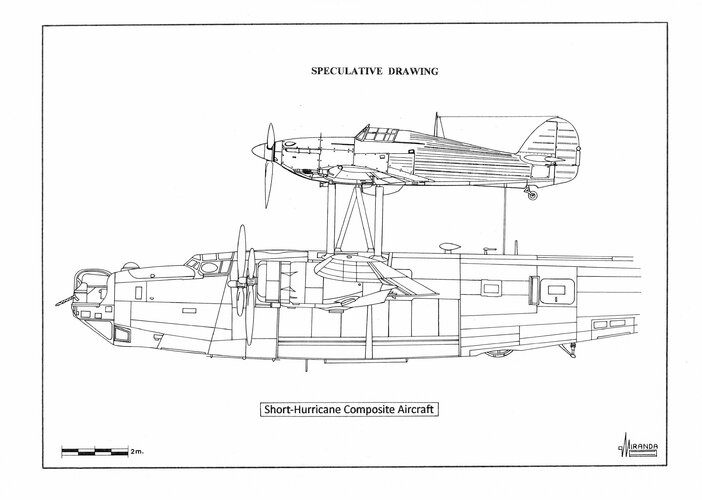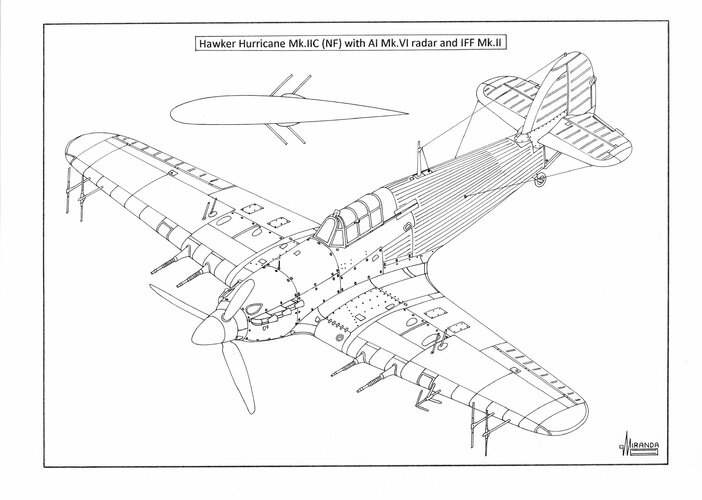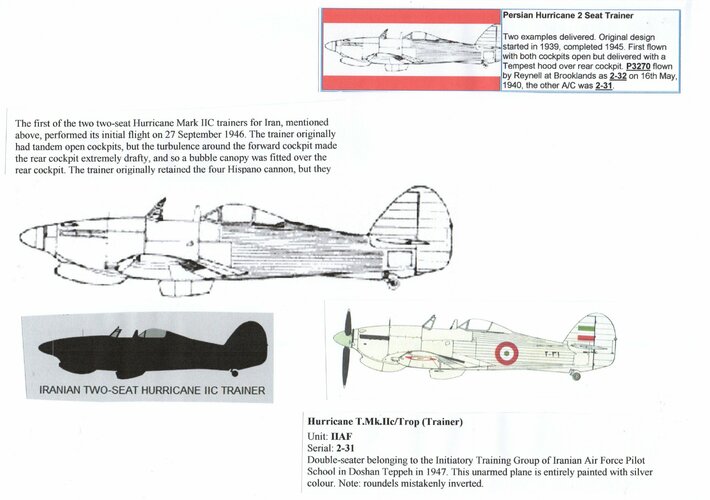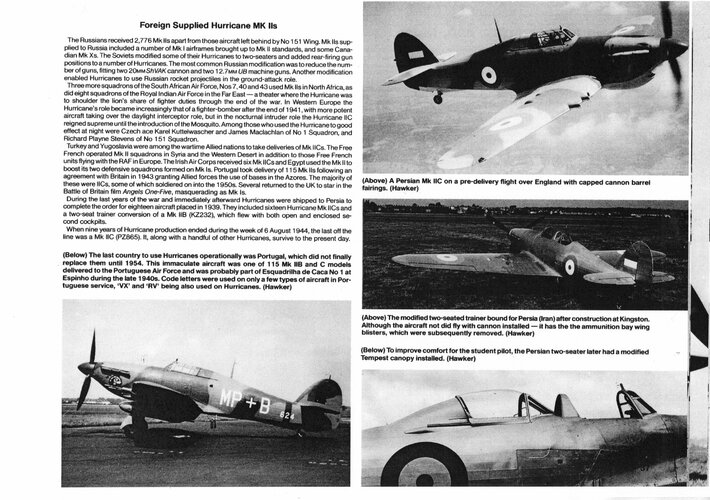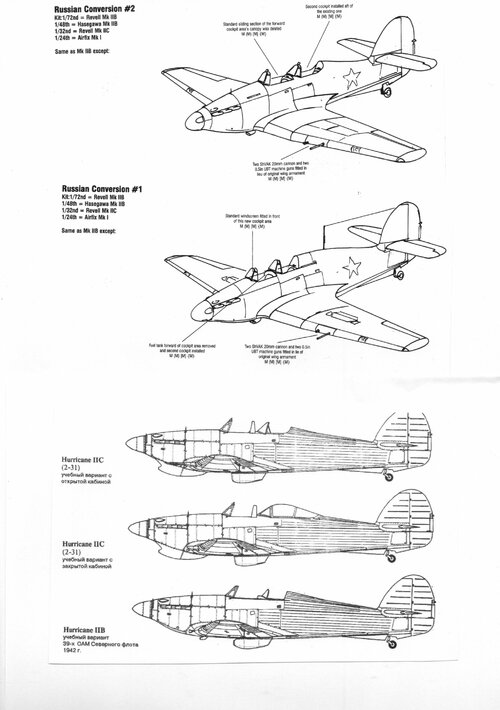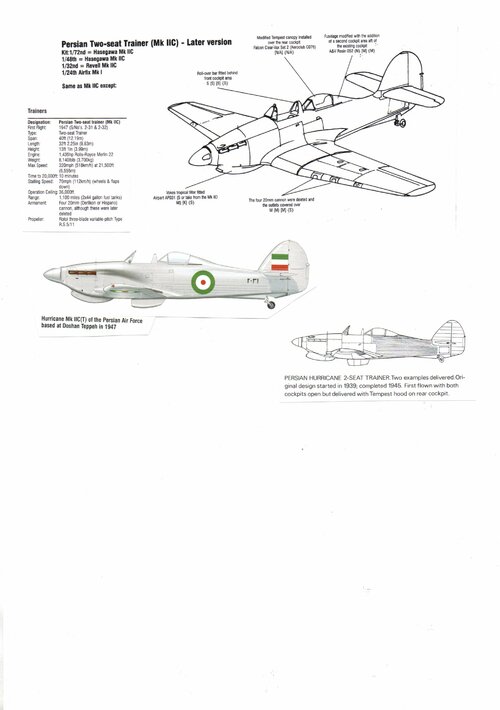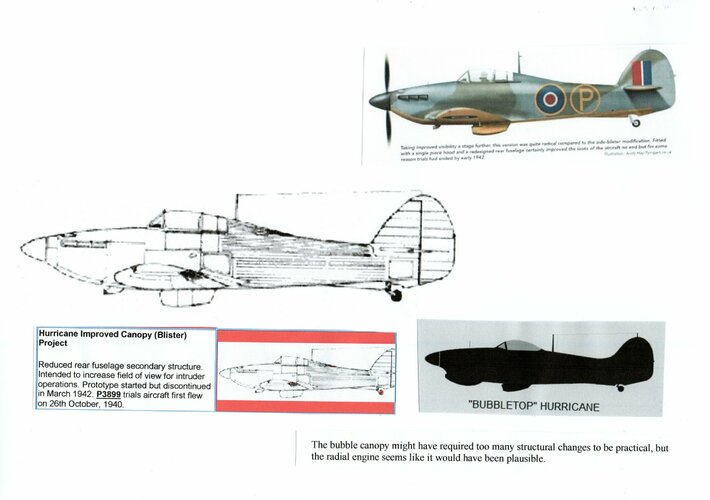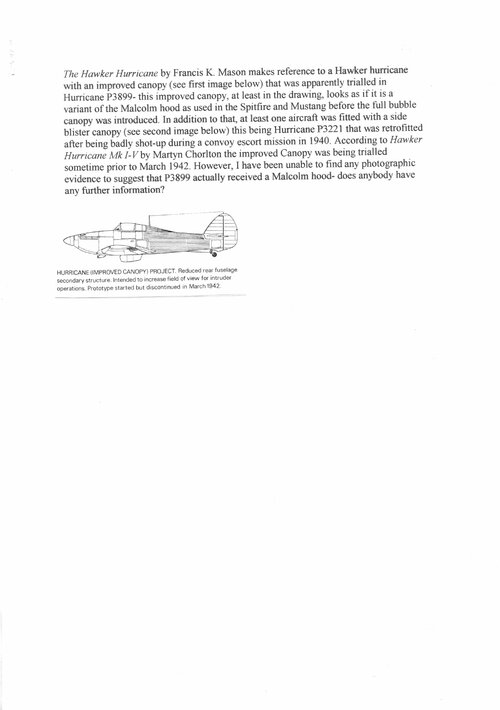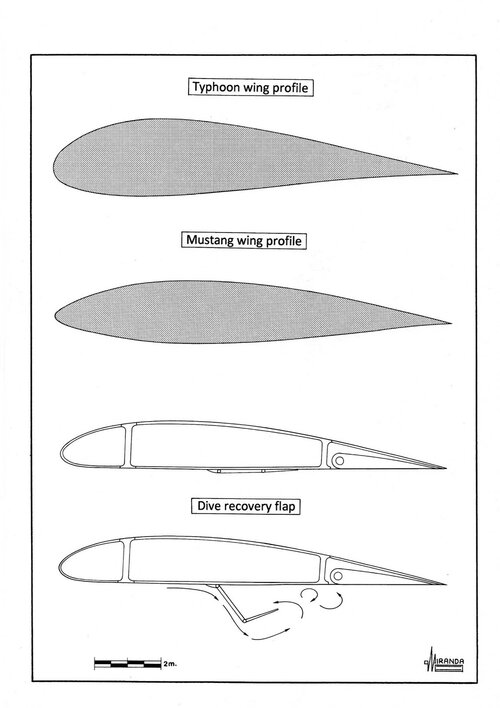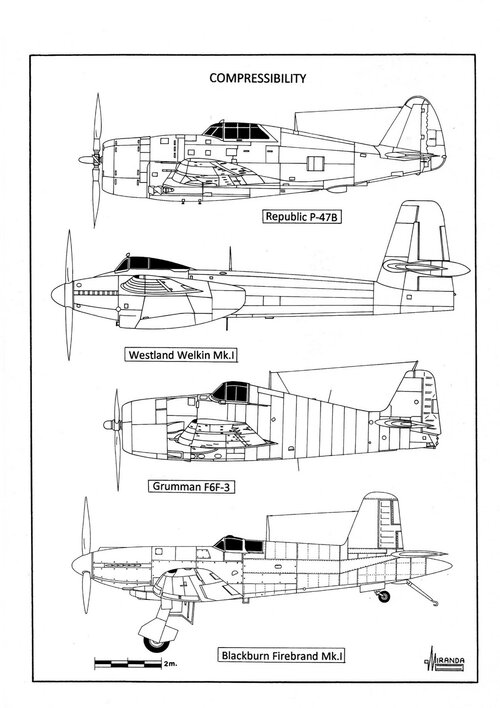Hawker Hurricane Evolution
During the ‘Phoney War’ (September to 10 May 1940) the Hawker
Hurricane Mk.I fighters of the British Expeditionary Force (B.E.F.) based in France and the Advanced Air Striking Force based in Belgium, performing well against the Messerschmitt Bf 109 C-1 and D-1 German fighters, but were unable to compete against the new Bf 109 E-1 and E-3 who began operating in the Occidental Front in May 1940 during the
Operation Fall Gelb.
Before starting the Battle of Britain the RAF had already lost 195
Hurricanes in the continent.
During tests carried out in May 1940 with a captured Messerschmitt Bf 109 E, it was found that, in realistic combat conditions, its manoeuvrability was inferior to that of the
Spitfire Mk.I although experienced pilots could make more closed turns by forcing the slats to the limit.
Despite being more manoeuvrable than the
Spitfire, the
Hurricane Mk.I had half the chance of survival in a confrontation with the Bf 109 E. Depending on the flight altitude, the
Hurricane was between 15 and 48 kph slower than the German BF 109 E and a difference of speed of more than 20 kph was considered lethal in 1940.
To reduce the number of loses, the Fighter Command banned flights over sea and the Fighter Control tried to lead the
Hurricanes only against the bombers, although it was very difficult to distinguish them from fighters with the radar of the time.
During the Battle of Britain the Bf 109 used to fly at great heights trying to surprise the British fighters while climbing to intercept the bombers. After a fast diving attack, they regained altitude to avoid the dog-fight below the 6,000 m.
The main concern of the
Hurricane pilots was the low rearward view of the cockpit and the Germans soon developed ‘hit-and-run’ tactics that could be used successfully against it. In April 1940 the
Hurricane Mk.I coded SD-K (P3221) was fitted with one improved canopy, with experimental
blister hood, to improve visibility to the rear. On 26 October 1940 flew the Mk.I (P3889) fitted with a single piece bubble canopy, taking improved visibility a stage further, but the modification might have required too many structural changes and the project was discontinued in March 1942.
In France, the
Hurricanes of the B.E.F. proved how difficult it was to shoot down a Heinkel He 111, with 270 kg armour, in 1940. The British pilots often exhausted their 2,600 ammunition rounds without obtaining visible results while the German bombers returned to their bases with more than 100 impacts of 7.7 mm and were repaired in a few days. These experiences influenced the design of the cannon armed
Hurricane Mk.II and
Spitfire Mk.V.
The British had acquired the manufacturing rights of the 20 mm Hispano-Suiza H.S. 404 cannon with explosive shells, but its installation on the wings of fighters was problematic. The weapon had been designed as an integral part of the Hispano-Suiza H.S.12 Y-31 engine and lacked structural strength to act independently. The adaptation was difficult, during the Battle of Britain some
Spitfires Mk.IB of the Nº 19 Sqn, experimentally equipped with two Hispano Mk.I cannons, suffering numerous stoppage problems. The RAF avoided its usage until the appearing of the Mk.II in the summer of 1941.
The F.37/35 proposal was issued to install four 20 mm wing-mounted Oerlikon FF cannons in the
Hurricane Mk.I (V7360) the prototype was flight tested at Langley in July 1940, but the project was rejected on 23 April 1936 in favour of the Westland
Whirlwind, a twin engine fighter faster than the
Spitfire Mk.II, Hurricane Mk.I and Bf 109 E at medium and low level, without adaptation problems to the early Hispano Mk.I drum feed version.
In late 1939 the
Hurricane Mk.I (L1750) was fitted experimentally with two 20 mm Oerlikon FF cannons housed in gondolas under the outer wing panels. Firing trials were performed at Boscombe Down test centre and the prototype fought in the Battle of Britain, but the Oerlikon was dropped in favour of the Hispano Mk.II cannon.
Several methods were considered to mitigate the lack of fire power, including air-to-air bombing with
Long Aerial parachute mines, dropped from a Handley Page
Harrow modified bomber of the Nº 420 Flight, and 3.25 inches rockets vertically fired from the rear fuselage of the
Hurricanes, a project named
Sunflower Seed.
To prove the idea, a
Hurricane Mk.I was modified to embody a single rocket tube, installed just aft the cockpit. On the first firing trial the fuselage was damaged, the fabric area around the mouth of the tube was reinforced with metal plates and other firings were accomplished satisfactorily, but the accuracy of the system was low and it was never used operationally.
The lack of the right engines in the international market during the World War Two, caused the appearance of many different prototypes of hybrid fighters. Engines and airframes of both bands were exchanged with experimental purposes.
In 1938 the Yugoslavian Government acquired 24 Hawker
Hurricane Mk.I fighters, together with the manufacturing licence to allow production of another 100 units in the factories of Zmaj and Rogozarski. However, by the time of German onslaught on April 1941, only 20 fighters had been delivered to the Royal Yugoslav Air Force.
When entering the war, the British Government suspended the exports of
Merlin engines, urgently needed for their own defence.
As an alternative, the engineers Ilic and Sivcev of the Ikarus-Zemun factory, experimentally installed the German Daimler Benz DB 601A engine in one of the
Hurricane IK-Z of local manufacturing. New engine bearers had to be built for the transformation, as well as a redesign of the electrical and cooling systems.
The new machine was named LVT-1 (Lovac Vazduhoplovno Tehnichi-1) and flight tested by the captain pilot Milos Bajagic in the Summer of 1940, proving better take-off performance and climb rate that either the
Hurricane Mk.I of the Bf 109 E-3
The Ikarus LVT-1
Hurrischmitt was a bit faster than the
Hurricane IK-Z although not as much as the Bf 109 E-3.
By early 1941, several proposals were made for the installation of alternative power plants in the Hawker
Hurricane Mk.II to alleviate possible shortages of
Merlin XX engines. The Rolls-Royce
Griffon IIA, Napier
Dagger and Bristol
Hercules engines were considered.
Britain had provided the Soviet Union a total of 2,952
Hurricanes and there were strong rumours that at least one of them was powered by one 1,250 hp Shvetsov ASh-82 radial engine and armed with two 20 mm ShVAK cannons and four 0.5 in UBT machine guns.
The
Hurricane airframe, designed in 1934, limited its potential development as a pure fighter and the series II, IV, V and XII, powered by one
Merlin XX engine with two-stage supercharger, were specialized versions in the ground attack role.
The Mk.IIB, a formidable strafing aircraft against soft targets, was armed with twelve wing-mounted 0.303-in Browning machine guns, the Mk.IIC with four wing-mounted 20 mm Hispano Mk.II cannons, remained in production for a variety of duties until 1944, the Mk.IID with two 40 mm Vickers ‘S’ antitank cannons housed in gondolas under the outer wing panels, the Mk.IIE with four wing-mounted Hispano Mk.II cannons and eight 3-in rockets under the outer wing panels.
The Mk.IV was powered by one
Merlin XX with four-blade propeller, the KZ706 prototype was flight tested with two experimental
Long Tom 500 lbs air-to-ground/anti-ship heavy rockets, launched from underwings rails, the Mk.V was powered by one
Merlin 32 and armed with two 40 mm Vickers ‘S’ cannons and the Mk. XII was powered by one Packard-
Merlin 29 engine and armed with twelve wing-mounted 0.303-in Browning machine guns.
Following the defeat in the Battle of Britain, the Germans increased his offensive against the shipping convoys in the North Atlantic.
The
Luftwaffe used long-range bombers Focke-Wulf Fw 200 C-1 of the I./KG40 based from Bordeaux-Merignac, these aircraft operated out the range of the British shore-based
Beaufighters.
As a result of enemy air action the Allies lost 32 merchant ships for the last quarter of 1940 and 88 ships for the first quarter of 1941.
With the loss of the HMS
Glorious and the HMS
Courageous, the Royal Navy did not have enough aircraft carriers to escort all convoys and Winston Churchill pressed for an interim solution.
In spring 1941, thirty-five merchant ships were to be converted to 'Catapult Aircraft Merchantman' (CAM Ships) with the installation of a 70 ft rocket catapult in the forward deck, to launch surplus
Hurricanes.
These
Hurricat /
Catafighters were standard Mk.Is, modified with catapult gear as
Sea Hurricane Mk.IA.
From November 1941 to July 1943, only eight catapult launches were made from CAM Ships, with six enemy aircraft shot down and the loss of one pilot.
The major drawback of the
Hurricat system was that, once the interception was completed, the fighter had to be ditched and the pilot would be picked up by the mother ship or by the nearest escort vessel, the average time to pick him up is between four and six minutes.
For artic operations the survivability was improved with the fitment of one Type K single-man dinghy.
The CAM system was dropped when some merchant ships were converted in small escort carriers (MAC ships) and a new type of fighter, fitted with catapult spools and arrester hook, was developed as
Sea Hurricane Mk.IB, for MAC operation.
Early in 1941, Colonel Stewart Menzies of the British Secret Intelligence Service, proposed the possibility of deploying a fighter pick-a-back on a bomber to attack the Focke-Wulf bombers in the North Western Approaches.
The RAF Coastal Command put forward a proposal to mount a Hawker
Hurricane Mk.IIC on top of an Armstrong Whitworth
Whitley modified bomber.
During the spring of 1941 Short Bros Ltd. proposed a variant of the
Short-Mayo Composite launch system mounting a
Hurricane Mk.IIC on top of a Consolidated B-24
Liberator bomber.
By the time of the
Composite design was complete, Sir Henry Tizard of the Aeronautic Research Committee, listed the impracticalities of the project. The main shortcoming was the insufficient range of the fighter to return to the base after being launched.
When the engine icing problems of the towed
Hurricane (V7480) were known the
Composite project was cancelled on 26 March 1941.
The problem could have been easily solved by installing an anti-icing system with hot air coming from the
Liberator engines and the
Hurricane Mk.IIC was designed to carry two underwing fuel tanks for extended range.
But provide full long-range protection of the convoys with
Composite aircraft required a prohibitive number of machines. Up to two squadrons may be necessary to each fighter maintained over one convoy and the number of
Composites required would be out of all proportion to the number of interceptions accomplished.
Given the large number of
Hurricanes built (near 14,000 units) there were many unusual variants, field modifications and uncompleted projects.
In April 1940 one Mk.I airframe was fitted with two modified Blackburn
Roc floats for operation in Norwegian coastal waters, the estimated top speed of the seaplane version was 210 mph at 10,000 ft.
Some Mk.I and Mk.II fighters were converted in Photo Reconnaissance (PR) airplanes with two cameras fitted under the rear fuselage and two 44 gallon auxiliary fuel tanks under the outer wing panels, these airplanes were painted in overall
Royal Blue.
In 1942 several Canadian built Mk.X were modified with fixed-ski landing gear for service in the Royal Canadian Air Force until 1943.
Experiments with degaussing coils carried by the Vickers
Vildebeeste (S1713) and the Handley Page
Arrow (K6998) were ineffective against the German magnetic mines, as the battery-generated magnetic field was insufficient to exploding them.
On 25 November 1939 Vickers proposed a
Wellington Mk.I conversion fitted with one 48 ft diameter degaussing hoop charged by one 85 Kw generator housed in the fuselage.
Flying at 25 ft and 170 mph the system performed well, but flying over the water at low-altitude and low-speed, with a useless compass and bad visibility, was difficult and when the mines exploding the
Wellington airframe suffered until 10g accelerations.
Theoretically a faster and more compact aircraft should suffer less structural damage when hit by shockwaves, in April 1943 the
Hurricane Mk.IIC (KZ381) was fitted with one 40 ft of diameter degaussing hoop, but during the flying tests the airplane displayed a tendency to stall and the experiment was discontinued.
In 1945 the Mk.IIB (Z3687) was fitted with a laminar-flow wing for research.
The Soviets also converted at least twenty
Hurricane Mk.IIB, Mk.IIC and Mk.XII to two-seat UTI trainers with open-cockpit configuration.
The BW948, BW945 and LW971 machines were used for artillery fire control in the Leningrad front in 1942, these airplanes were armed with two 20 mm wing-mounted ShVAK cannons and two 12.7 mm UB heavy machine guns.
The turbulence around the forward cockpit made the rear cockpit extremely uncomfortable, in 1947 two T.Mk.IIC/Trop Persian trainers, of the Doshan Teppeh Pilot School, were fitted with a modified
Tempest canopy over the rear cockpit.
Late 1945 the Mk.IIA (INST 257) was converted as a taxying and brake control trainer and used in the Nº1 (Indian) Flying Training School at Ambala.
The airplane, coded ‘-DODO’, was fitted with two lateral tube seats framing, a strut-mounted nose wheel, and rendered flightless by the addition of metal angle spoilers over the outer wing panels.
On January 1941 Malta needed fighters, but none of the airplanes that could be made available gave sufficient range for Malta to be reached from Gibraltar.
As an alternative to the dangerous reinforcement by sea, test were conducted with the
Hurricane Mk.I (V7480) towed by a
Wellington Mk.IC converted bomber with a towing frame in place of the tail turret.
The fighter was fitted with hydraulically operated Malcom towing hooks on the outer wing panels and 200 ft of steel cable shackled to a towing bridle some 15 ft in front of the aircraft.
A number of towing trials were undertaken at Flight Refuelling-Staverton in March 1941, but the
Merlin engine suffered severe icing and would not start after prolonged inactivity at high-altitude. The whole project was dropped.
Another experiment to increase the
Hurricane range was the Hillson FH.40 device, a detachable top wing with integral fuel tank and the same planform and airfoil section as the
Hurricane wing. The FH.40 wing weighted 630 lbs, including the release gear and struts.
The modification was implemented by F.Hills & Sons and fitted in the
Hurricane Mk.I (I321) ex-Canadian (L1884), by ‘N’ type inter-plane struts.
The theory was that the top-wing giving additional lift to facilitate the take-off on heavily-laden escort fighter, it would be jettisoned via an electric solenoid slip device.
In December 1943 the prototype was flight tested at the Boscombe Down Experimental Establishment, but trials were limited to a 7,800 lbs low weight configuration and the wing was never released. In January 1944 the scheme was abandoned as impractical.
On the night of June 18, 1940 the
Luftwaffe launched its first night raid against England, at that time the
Blenheim Mk.I F night fighter, underpowered by two 840 hp Bristol
Mercury VIII radial engines, reached a maximum speed of 423 kph, against the 425 kph of the Heinkel He 111 H-3 and the 450 kph of the Junkers Ju 88 A-1. The
Blenheim Mk.I F could only catch the Dornier Do 17 M-1 (344 kph) after a long chase and the Fighter Command was forced to use its single-engine day fighters in dangerous night missions.
The Gloster
Gladiators Mk.II of the Nº 247 Sqn (code HP), Hawker
Hurricanes Mk.I from Squadrons Nos. 73 (HV), 85 (VY), 87 (LK), 92 (GR), 96 (ZJ) and 151 (GG) and Supermarine
Spitfires Mk.I from Sqn Nos. 19 (WZ), 41 (PN), 72 (RN), 74 (ZP), 62 (ZT), 603 (XT) and 616 (YQ) were pressed into the night fighting role.
It was intended that the day fighters would intercept raiders illuminated by searchlights. Exhaust flame dampers had not been fitted to these aircraft and the pilots lost the night vision, even during take-off, and it will take 20-30 min to re-establish.
Between July 10 and August 11, 1940, these night flights caused 28 accidents (a quarter of the Fighter Command's losses) and the deaths of seven pilots.
On November the Fighter Command ordered the overall black paint scheme for night fighters and proposed new interception tactics in which night patrols were 10 thousand behind the front line of searchlights. Tests were also carried out with a GCI control, the new AMES IFF Mark I
Pip-squeak recognition equipment was installed in some night fighters. German Lorenz FuSAn 721 receivers to hunt along
Knickebein navigation beams were installed in some
Blenheims. Night fighters that did not have IFF had to signal their position using identification lights operated in Morse code.
In 1941 some
Hurricane Mk.I were transformed into Mk.I NF night fighters with the installation of six exhaust pipes, anti-dazzling exhaust flame shields, Rotol propellers and Ferranti IFF Mark II devices that used two wire antennas extended between fuselage sides and tailplane tips.
These aircraft were painted overall in R.D.M.2
Special Night Black with standard roundels,
Medium Sea Grey code letters and
Dull Red serials. In some cases the underside roundels were overpainted
Flat Black.
In May 1941 the No. 245 Sqn (DX) from Aldergrove was pressed into a night fighting role, followed in July by No. 213 Sqn (AK) used for the night defense of Famagusta-Cyprus and No. 30 Sqn (RS) based in Alexandria.
During the year the
Hurricane Mk.I NF managed to bring down two He 111s, one Ju 88 and one Do 17. In April enter into service the Mk.IIB NF version with
Merlin XX engine, twelve 0.303 in Browning machine guns, IFF Mark II,
Fish-tail triple ejector exhaust (that affected neither the 540 kph top speed nor night visibility) and anti-dazzling
blinkers.
During the month they were also used in Scapa Flow's defense operating with the No. 3 Sqn (JX), in July they participated in the defense of Malta with the MNFU night fighting unit and in December began operating with the 'B' Flight of No. 253 Sqn (SW) from Hibaldstowe-Lincolnshire. In May enter into service the
Hurricane Mk.IIC, a night intruder with 4x20 mm Hispano cannons, 529 kph max speed,
Fish-tail exhaust stacks, anti-dazzle guards and IFF Mark II.
During the second half of 1941 these aircraft made numerous night fighter and night intruder operations over German airfields in Northern France and the Netherlands.
The Mk.IIC used the same paint scheme as the Mk.IIB NF although some aircraft of the No.1 Sqn (JX) used the day disruptive pattern of
Dark Green and
Ocean Grey type M (matt) with R.D.M.2a undersurfaces.
In total, 4,711 Mk.II units were built operating with 82 Squadrons.
To combat the German ‘Winter Blitz’ (June-December 1940) there was a proposal to equip the
Spitfires,
Hurricanes and
Typhoons with a radar set specifically designed for operation in single-seat night fighters.
In 1941, the EMI engineering team developed the AI Mk.VI, one 10 Kw Airborne Interception radar, with 500 ft to 3 miles detection range and automatic range strobe, dispensing with the need for an operator.
In April 1942 the new radar was tested in combat by some
Defiants Mk.II of the Nº 264 Sqn and the order for twelve
Hurricane Mk.IIC (NF), fitted with AI Mk.VI radar, was placed.
The prototype (BN288) flew on June 1942, but early flight trials with the Mk.VI radar set showed an undesirable shortcoming: the night vision of the pilot would be quickly destroyed by the radar screen glare.
Air Military publication, written in September 1943, describes the difficult task of watching the 4-inch diameter cathode-ray tube and looking out in the darkness for the enemy.
The Germans partially solved the problem using anti-glare red filters in the radar screen, anti-glare red pilot goggles and ultra-violet illumination for the instrument panel of their single-seat night fighters.
In November 1942 six
Hurricanes Mk.IIC (NF), fitted with wing-mounted transmitting dipoles type 69, Azimuth dipoles vertically polarised and elevation antennas type 29, were delivered to the Nº 245 Sqn and another six to the Nº 247 Sqn for operational trials.
The new fighter was found top-heavy and difficult to handle, the drag generated by the antennae and the long-range fuel tanks required to give extended patrol endurance, considerably reducing the top speed and the airplane was unable to catch the new German night intruders Junkers Ju 88 A-4.
Early 1943 all the Mk.IIC (NF) were shipped to India.
On June 1943 were delivered to the Nº 176 (NF) Squadron for the defence of Calcutta from the Ki.21, Ki.48, G4M and H6K Japanese night raiders.
The Mk.IIC (NF) remained operational until January 1944.


 hushkit.net
hushkit.net
